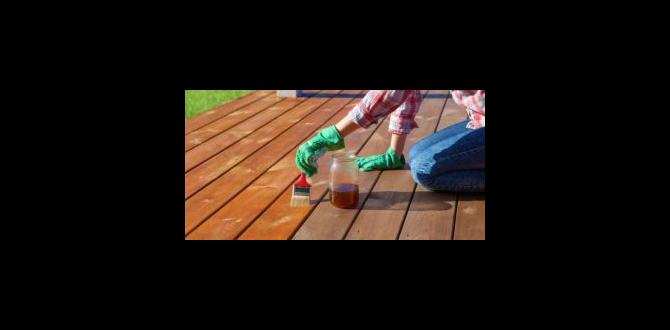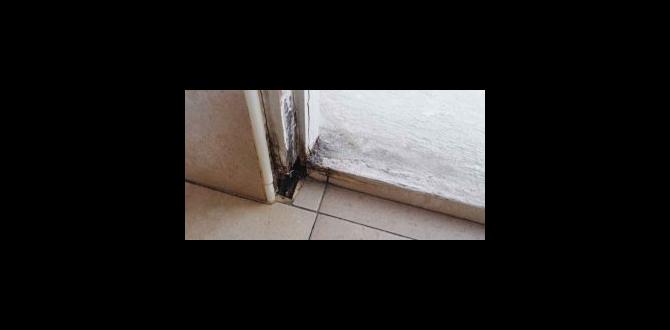Have you ever looked at a favorite piece of furniture and found holes in the wood? Or maybe you’ve seen soft, crumbling wood on your porch? These signs mean you have wood rot. It’s a common problem that surprises many homeowners. It can start small, but if you ignore it, it can get much worse.
Did you know that wood rot can spread quickly? Just a small spot can turn into a big issue. But don’t worry! You can learn how to fix wood rot with some tips from the experts. They have tested methods that actually work. With the right tools and a little effort, you can make your wood strong again.
Imagine having a home that’s safe and sound. Strong wood beams and sturdy furniture make a big difference. It feels good to know you can take care of your home. So, ready to dive in? Let’s uncover expert tips for a lasting solution to wood rot!
Table of Contents
How To Fix Wood Rot: Expert Tips For A Lasting Solution Wood Rot Is A Common Problem That Affects Homes And Structures, Especially Those Made Of Wood. Understanding How To Fix Wood Rot Is Essential For Maintaining The Integrity And Aesthetics Of Your Property. In This Article, We Will Provide Expert Tips And Essential Steps To Effectively Address Wood Rot And Ensure A Lasting Solution. Understanding Wood Rot Wood Rot Occurs When Wood Is Damaged By Decay Fungi, Which Thrive In Damp, Humid Environments. There Are Two Primary Types Of Wood Rot: Dry Rot And Wet Rot. Identifying The Type Of Wood Rot You Are Dealing With Is Crucial For Selecting The Appropriate Repair Methods. Identifying Wood Rot Before You Can Fix Wood Rot, You Need To Accurately Identify It. Look For Signs Such As Discoloration, A Soft Or Spongy Feel To The Wood, And In Severe Cases, A Musty Smell. If You Find These Signs, It’S Essential To Address The Issue Promptly To Prevent Further Damage. Step 1: Evaluate The Damage Examine The Affected Area To Determine The Extent Of The Rot. If The Wood Is Merely Surface-Level, You May Be Able To Repair It With Wood Fillers Or Epoxies. However, If The Rot Has Penetrated Deeply, You May Need To Replace Entire Sections Of Wood. Step 2: Remove The Rot For Repair, You Must Remove All Of The Rotted Wood. Use A Chisel Or A Rotary Tool To Carefully Excavate The Damaged Area. Be Thorough, As Leaving Any Remnants Of Rot Can Lead To Recurrence. Step 3: Treat The Area Once The Rotted Wood Has Been Removed, Treat The Area To Prevent Future Decay. Apply A Fungicide Or A Wood Preservative To The Exposed Wood. This Will Help Protect It Against Moisture And Fungal Growth. Step 4: Replace Or Repair The Wood In Cases Where Extensive Damage Has Occurred, Replacing The Affected Wood May Be Necessary. When Doing So, Ensure That The New Wood Is Properly Treated To Withstand Moisture. For Smaller Jobs, Wood Fillers Or Epoxy Can Be Used To Repair The Damage. Step 5: Seal And Protect To Prevent Further Wood Rot, It’S Vital To Seal The Repaired Area. Use High-Quality Paint Or Sealants That Provide Waterproof Protection. This Step Is Crucial For Areas Exposed To The Elements. Additional Tips For Prevention – Regularly Inspect Wooden Structures For Signs Of Moisture Or Rot. – Maintain Proper Drainage Around Your Home, Directing Water Away From Wooden Elements. – Ensure Good Ventilation In Areas Prone To Humidity, Such As Basements And Attics. – Apply Protective Coatings Regularly To Prevent Moisture Intrusion. Conclusion Knowing How To Fix Wood Rot Is Vital For Homeowners Trying To Maintain Their Properties. By Following These Expert Tips, You Can Effectively Tackle Wood Rot And Ensure A Lasting Solution. Regular Maintenance And Prevention Techniques Will Keep Your Wooden Structures Safe From Decay In The Future.

How to Fix Wood Rot: Expert Tips for a Lasting Solution
Wood rot can quietly destroy your home. Fixing it doesn’t have to be hard. Begin by identifying the rot in your wood, then remove the damaged parts. Use a wood hardener to strengthen the remaining wood. Don’t forget to treat the area with a protective sealant to prevent future issues. This simple process can save your home and keep it strong. Remember, acting quickly can stop wood rot in its tracks!Understanding Wood Rot
Definition and causes of wood rot. Types of wood rot: brown rot vs. white rot.Wood rot is like a sneaky villain for your favorite wooden things. It begins when moisture gets into the wood, leading to damage. Causes include too much rain, leaking pipes, or poor ventilation. There are two main types: brown rot and white rot. Brown rot munches on the wood, leaving it crumbly and weak, while white rot turns the wood mushy, almost like it’s made of a sponge. Wood rot doesn’t just ruin your chairs; it also wants your emails!
| Type of Wood Rot | Appearance | Impact on Wood |
|---|---|---|
| Brown Rot | Crumbly, darkened | Weakens wood structure |
| White Rot | Soft, spongy | Makes wood mushy |
Identifying Wood Rot in Your Home
Signs of wood rot to look for. Tools and methods for detection.Wood rot can damage your home if not found early. Signs of wood rot include soft or crumbly wood, dark spots, and a musty smell. If you notice any of these, it’s time to check further. You can use simple tools, like a screwdriver or a utility knife, to poke at the wood. If it feels spongy, that’s a bad sign. Here are some tools to help find wood rot:
- Screwdriver
- Utility knife
- Moisture meter
- Flashlight
Be alert, as finding wood rot early can save you big repairs!
What are the signs of wood rot in your home?
Signs include soft wood, dark patches, and a bad smell. Always check damp or shaded areas, as wood rot likes moisture!
Assessing the Damage
How to evaluate the extent of wood rot. Determining if replacement or repair is necessary.Start by looking closely at the wood. Check for soft spots or discoloration. Use a knife to poke the wood gently. If it feels mushy, that’s a sign of damage.
Next, decide if you can fix it or if it’s better to replace it. Here are some questions to help you:
- Is the rot deep or just on the surface?
- Is this a small area, or is it widespread?
- Can you still hold the wood or support weight?
If the rot is too large, replacement is usually best for a lasting solution.
How can I tell if wood rot can be repaired?
Check for soft wood and extensive damage. If you can poke right through, it’s likely too far gone. Repair works well for minor rot, but large areas may need a replacement.
Essential Tools and Materials for Repair
List of tools needed for fixing wood rot. Recommended materials for effective repairs.Before diving into wood repair, gather your tools. You’ll need a hammer for knocking things into place and a screwdriver for tightening those pesky screws. A chisel helps remove rotten pieces, while a saw lets you cut new wood. Don’t forget sandpaper for smoothing rough edges! Here’s a handy table for a quick overview:
| Tools | Purpose |
|---|---|
| Hammer | Drive nails into wood |
| Screwdriver | Tighten and remove screws |
| Chisel | Remove rot from wood |
| Saw | Cut new wood |
| Sandpaper | Smooth out surfaces |
For materials, choose durable wood fillers and waterproof sealants. These will keep your repairs strong and resist future rot. Remember, a well-equipped repair is half the battle! And if all else fails, find a friend who can help—two heads are better than one (especially if one’s handy with tools)!
Step-by-Step Guide to Repairing Wood Rot
Detailed process for minor repairs. Procedures for major repairs and replacement.First, look closely at the wood. If it’s soft, you likely have rot. For minor repairs, remove the rotten parts using a chisel. Fill gaps with wood filler and sand it smooth. For major repairs, you may need to replace whole pieces of wood. Cut the bad wood away and measure the new piece carefully. Fit the new piece in place and secure it with nails or screws. Finally, paint or stain to protect the wood.
What supplies do I need for fixing wood rot?
You’ll need:
- Chisel – to remove rot
- Wood Filler – to fill gaps
- Sanding Block – for smoothing
- Nails or Screws – for securing
- Paint or Stain – for protection
Fixing wood rot can extend the life of your wood. Regular checks help catch issues early. Did you know that rotten wood can impact your home’s stability? Always take action when you find rot!
Preventing Future Wood Rot
Best practices for moisture control. Treatments and sealants to protect wood.To keep wood healthy and strong, controlling moisture is crucial. Make sure areas near wood are always dry. You can follow these best practices:
- Install gutters to direct rain away.
- Use a dehumidifier in damp places.
- Seal wood with protective coatings.
Using treatments like water-repellent sealants can help. They block moisture, keeping wood safe. Regularly check for leaks and fix them quickly. This will stop rot before it starts!
How can I protect my wood from moisture?
You can protect your wood by using sealants, keeping the area dry, and checking for any leaks regularly.
When to Call a Professional
Signs that indicate a professional is needed. How to choose the right contractor for repairs.Sometimes, fixing wood rot is too hard for DIY. Here are signs that tell you when to call a pro:
- Large areas of rot are visible.
- New signs of damage appear often.
- It affects the structure of your home.
- You feel unsure about making the repairs.
Choosing the right contractor is important. Look for someone who:
- Has good reviews from customers.
- Is licensed and insured.
- Can show past work examples.
- Offers a clear estimate for the work needed.
Taking these steps helps ensure a lasting fix.
How can I tell if I need to hire a professional?
If you see extensive damage or feel unsure about the repair, it’s time to call a professional. They can fix issues safely and effectively.
Cost Considerations for Wood Rot Repair
Average costs associated with various repair methods. Factors affecting the cost of professional services.Repairing wood rot can vary in cost. On average, simple repairs may cost around $300 to $800. More extensive fixes can reach $2,000 or more. Prices depend on several factors:
- Severity of Damage: More damage means more work needed.
- Material Costs: Different types of wood have varying prices.
- Labor Cost: Skilled workers charge more.
- Location: Costs can change based on where you live.
Understanding these factors can help you budget better for your project.
What are the average costs of wood rot repair?
The average cost for wood rot repair can be between $300 and $2,000 based on damage extent and repair type.
Conclusion
In conclusion, fixing wood rot is important for keeping your home safe and strong. First, identify the problem area. Then, remove the damaged wood and treat the rest. Finally, fill in gaps and protect with paint or sealant. You can do this! For more tips and detailed steps, check out our other articles. Happy repairing!FAQs
What Are The Most Common Signs Of Wood Rot To Look For In Your Home?You can look for a few signs of wood rot in your home. First, check for soft or spongy spots in the wood. You might also see dark, stained areas or mold. If wood feels wet or smells musty, that’s a bad sign. Finally, look for cracks or holes in the wood.
How Can I Effectively Prevent Wood Rot From Occurring In The First Place?To prevent wood rot, keep wood dry and clean. Make sure water doesn’t sit on the wood. You can paint or stain the wood to protect it. Also, keep trees and plants away from wooden structures. This way, you help the wood stay safe from moisture and rot!
What Tools And Materials Do I Need To Repair Wood Rot Successfully?To repair wood rot, you need a few tools and materials. First, get a chisel to remove the rotten wood. You will also need sandpaper to smooth the area. Use wood filler to fill in the gaps and a paintbrush to apply it. Finally, buy some paint or sealant to protect the wood after you’re done.
Is It Possible To Treat And Stabilize Rotted Wood, Or Should It Always Be Replaced?Yes, you can treat and stabilize rotted wood in some cases. You can use special products to help stop the rot. These products can make the wood stronger again. However, if the wood is very damaged, it’s usually better to replace it. Always check if it’s safe to keep using the wood.
How Do Environmental Factors, Like Moisture And Temperature, Contribute To Wood Rot And How Can I Mitigate Them?Moisture and high temperatures can cause wood to rot. When wood gets wet, it becomes soft and weak. Fungi and insects love warm, damp wood and can break it down. To stop this, you can keep wood dry by fixing leaks and using paint or sealant. You can also keep wood in a cool, dry place.






